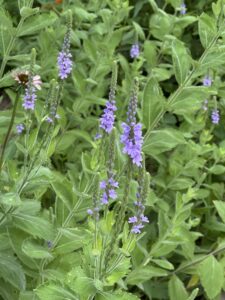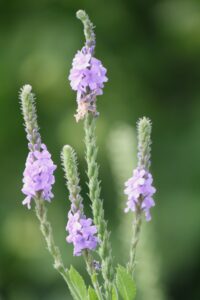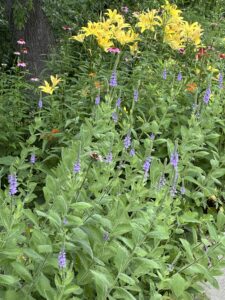Hoary Vervain (Verbena stricta)

– Light: Full to part sun.
– Soil and water: Medium-dry to dry average garden soil.
– Hardiness Zone: Zones 3-8.
– Size: About 2 feet tall. Will lean towards the sun and might sprawl. If you want this plant to always stand straight and tall, consider using a plant support.

– Bloom period and color. Deadheading. Blooms blue/purplish blue from late June through September. To get the longest period of bloom, deadhead the completely finished flowers by looking carefully at each stem and cutting just above a set of leaves where a small bud is forming. (For photographs demonstrating this, click on this link: Purple Coneflower (Echinacea purpurea).) If you check and deadhead every 2 weeks or so, the plant will continue blooming and blooming. It will be one of your longest blooming perennials. This is a wonderful trait. The butterflies will thank you!
– Insects, butterflies, and birds?: Beneficial insects and smaller butterflies will use this plant. Sparrows, finches, and juncos will feast on the seeds.
Deer, rabbits, and other pests: Hoary Vervain is considered to be a weed by farmers in their pastures with livestock. Cattle, dairy cows, sheep, and horses, will not eat it. I am wondering if whatever it is they dislike about the plant is also true for deer and rabbits? I have had Hoary Vervain in my garden for several years and we have both deer and rabbits and not one leaf on any of these plants has ever been touched. Just keep in mind, your experience could be different – especially if you live in the midst of a large herd of deer or are over-run with rabbits.

All of my plants have also been disease free. Aphids and Japanese beetles have never bothered them.
– Propagating and transplanting: Hoary Vervain can be transplanted during its first growing season in your garden. Choose your spot carefully as in the second year, transplanting will be more difficult. You will need a sharp shovel and the ability to dig a large and fairly deep hole as this plant has an extensive and deep root system. After the second, year, in my opinion it cannot be transplanted. The tap root is too deep and the root system is too extensive.
This plant will self-seed. I have not found it to be a prolific self-seeder in my garden, but from reading about the plant, other gardeners have found volunteers all over their garden. Be aware you could have either experience. I would welcome volunteers in my garden! You can also collect seeds. They require a cold stratification period of 60 days, but after that, they germinate quickly. Seeds can be planted in fall or spring.
I truly love this plant for its long bloom. Summertime is heavy with yellows and oranges. The blue flowers are a welcome contrast. I would recommend you plant several of these plants together – if you plant just one, the plant can get lost among all the other summer bloomers. It is beautiful when massed together. I have 12 in a large plot along my driveway and love to see them every time I come home.
What to plant with Hoary Vervain: Asiatic lilies, Shasta Daisies (Leucanthemum × superbum), Black-eyed Susans (Rudbeckia hirta), Ironweed (Veronia), and Coneflowers (Echinacea).

